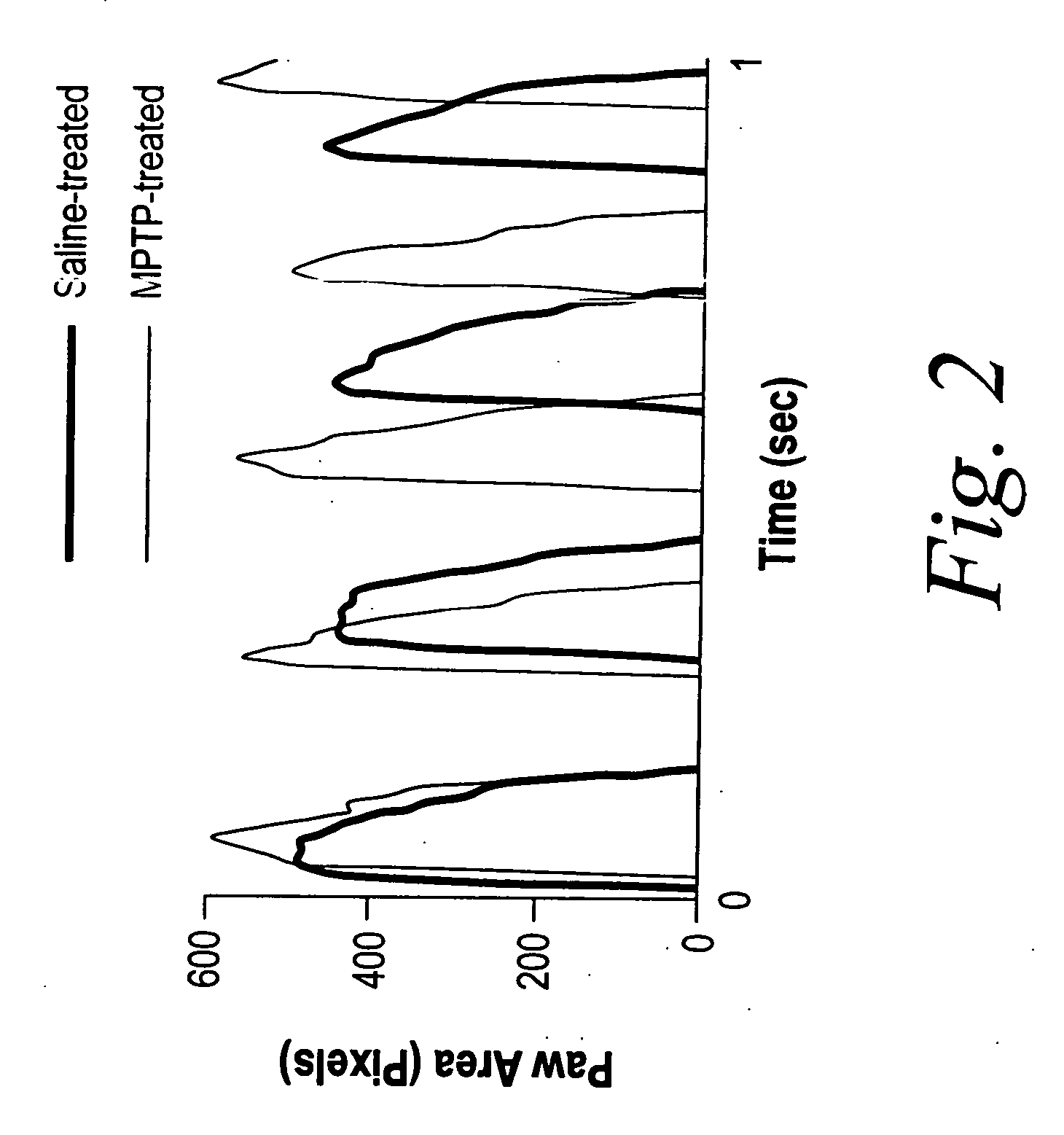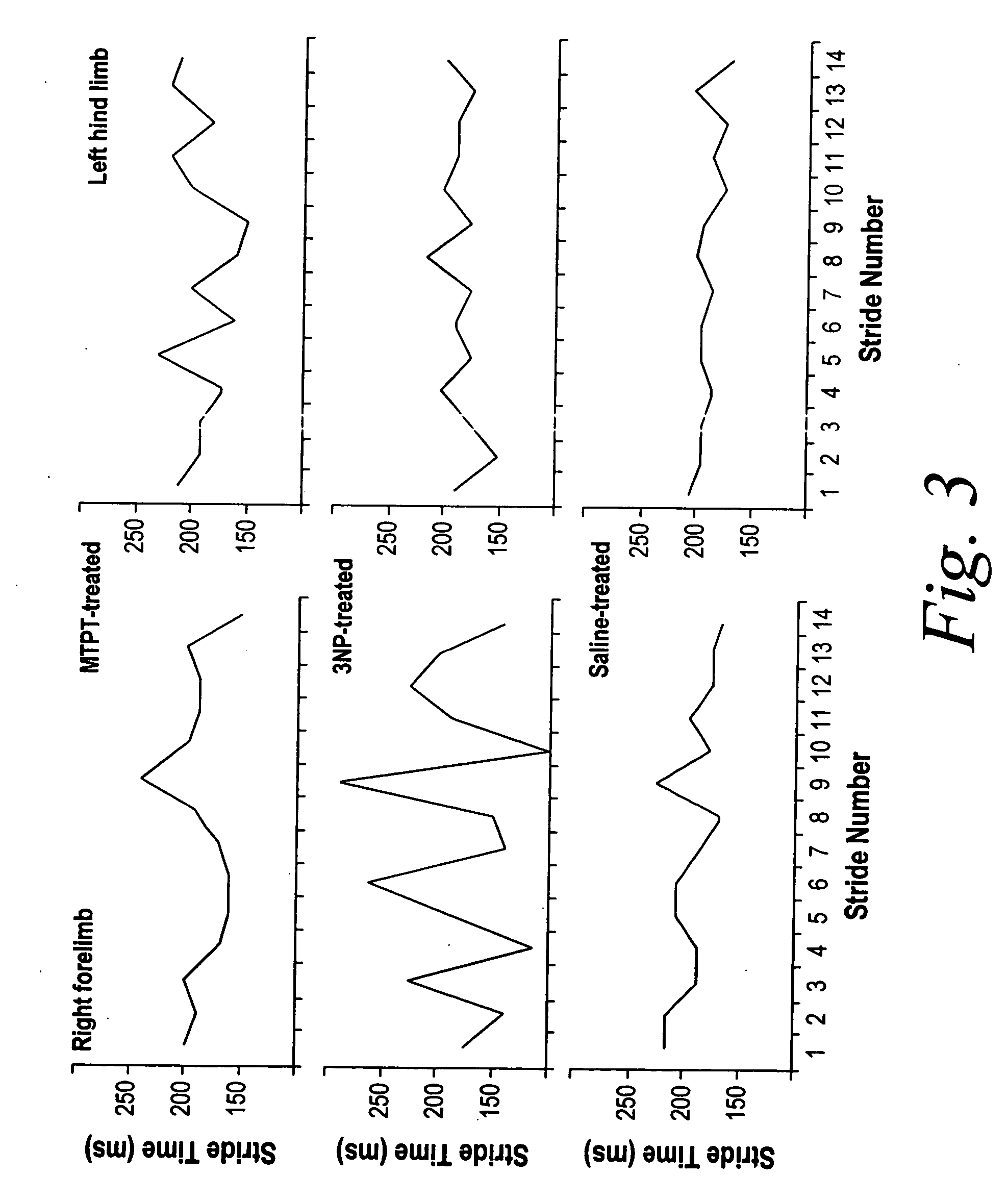Measurement of gait dynamics and use of beta-blockers to detect, prognose, prevent and treat amyotrophic lateral sclerosis
a technology of gait dynamics and beta-blockers, applied in the field of measurement of gait dynamics and use of beta-blockers, can solve the problems of respiratory failure, loss of the ability of the brain to control voluntary movement, and inability to breathe without ventilatory support, so as to prevent, delay, or mitigate the symptoms of als in a subject, and prevent weight loss
- Summary
- Abstract
- Description
- Claims
- Application Information
AI Technical Summary
Benefits of technology
Problems solved by technology
Method used
Image
Examples
example 1
Gait dynamics in Saline-Treated Mice
[0151] Gait dynamics were initially examined in control (saline-treated) mice. Walking at a speed of 34 cm / s, wild type C57BU6J mice achieved ˜5 steps every second, completed one stride within ˜200 ms, and traversed ˜7 cm with each step (refer to the upper panel of FIG. 1, which depicts the ventral view of a C57BL / 6J mouse walking on a transparent treadmill belt; also refer to the lower panel of FIG. 1, which displays representative gait dynamics signals for the left forelimb and right hind limb of a saline-treated mouse walking at a speed of 34 cm / s). The contributions of stance and swing durations to stride duration were ˜55% (stance / stride) and ˜45% (swing / stride), respectively. Forelimb stance width was significantly narrower than hind limb stance width (1.7±0.1 cm vs. 2.4±0.2 cm, P<0.05). The paw placement angle of the hind limbs was significantly more open than the paw placement angle of the forelimbs (13.9±1.6 vs. 2.6±0.6, P<0.05). Stride ...
example 2
Gait Dynamics were Altered in MPTP-Treated Mice
[0152] To investigate the effect of MPTP treatment on gait, the impact of MPTP treatment on gait dynamics was assessed. Gait dynamics in MPTP-treated mice following 3 administrations of 30 mg / kg MPTP were significantly different than gait dynamics in saline-treated mice (refer to Table 1 and FIG. 2). Stride length was decreased in MPTP-treated mice compared to saline-treated mice (6.6±0.1 cm vs. 7.1±0.1 cm, P<0.05) at a walking speed of 34 cm / s. Stride frequency was increased in MPTP-treated mice. Stride duration was significantly shorter in MPTP-treated mice (194±1 ms vs. 207±2 ms, P<0.05). This was attributable to a shorter swing duration of the hind limbs (92±3 vs. 104±2 ms, P<0.05), and a shorter stance duration of the forelimbs (116±2 ms vs. 126±2 ms, P<0.05). The contributions of stance and swing to stride duration in MPTP-treated mice were not different than in saline-treated mice, despite the shorter stride duration. Forelimb s...
example 3
Gait Variability was Altered in MPTP-Treated Mice
[0154] Further assessment of the effect of MPTP treatment on gait was performed by measuring the impact of MPTP treatment on gait variability. Gait variability was significantly higher in MPTP-treated mice after 3 treatments compared to saline-treated mice. Stride length variability of the forelimbs was higher in MPTP-treated than in saline-treated mice (0.91±0.04 cm vs. 0.78±0.03 cm, P<0.05). Stride length variability of the hind limbs, however, was not different in MPTP-treated mice. The coefficient of variation (CV) of forelimb stride length was significantly higher in MPTP-treated than in saline-treated mice (13.6±0.8 % vs. 11.1±0.8 %, P<0.05). The CV of hind limb stride length was somewhat higher in MPTP-treated than in saline-treated mice (10.0±1.5 % vs. 8.0±0.7 %, NS). (Refer to the top panel of FIG. 3, which shows stride time dynamics for 14 sequential strides in a MPTP-treated mouse. For comparison, stride time dynamics in a...
PUM
| Property | Measurement | Unit |
|---|---|---|
| Length | aaaaa | aaaaa |
| Angle | aaaaa | aaaaa |
| Strength | aaaaa | aaaaa |
Abstract
Description
Claims
Application Information
 Login to View More
Login to View More - R&D
- Intellectual Property
- Life Sciences
- Materials
- Tech Scout
- Unparalleled Data Quality
- Higher Quality Content
- 60% Fewer Hallucinations
Browse by: Latest US Patents, China's latest patents, Technical Efficacy Thesaurus, Application Domain, Technology Topic, Popular Technical Reports.
© 2025 PatSnap. All rights reserved.Legal|Privacy policy|Modern Slavery Act Transparency Statement|Sitemap|About US| Contact US: help@patsnap.com



